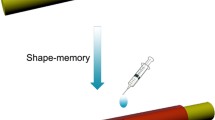Abstract
A biodegradable copolymer of poly L-lactic acid and ε-caprolactone (PLAC) was manufactured into a tube, in which a denatured skeletal muscle segment was placed longitudinally. This model tube was implanted as a guide to promote nerve regeneration across a 5 cm gap in the rabbit sciatic nerve. Five months after implantation, good nerve regeneration was found throughout the graft and in the distal host nerve. The population (29.6/16 x 10p2 μmp2) of regenerated nerves in the graft was higher than that of the contralateral normal sciatic nerve (18.0/16 x 10p2 μmp2). Regenerated nerve fibers extended to the distal host nerve. The number of myelinated fibers was 13.7/16 x 10p2 μmp2 at a level 1.5 cm from the distal suture. The diameters (below 2 μm) of most regenerated myelinated nerves in the graft and in the distal host nerve were much smaller than those (6-8 μm) of normal nerves. Electrophysiological evaluation showed that the hindlimb muscle (gastrocnemius) was innervated by motor nerves in all animals 5 months after implantation. These results indicate that the PLAC tube with a denatured muscle segment inside provided good conditions for nerve fiber regrowth. The PLAC tube is thought to protect the denatured muscle segment from rapid dissociation in the host tissue.
Similar content being viewed by others
References
Brandt J, Dahlin LB, Lundborg G (1999) Autologous tendons used as graft for bridging peripheral nerve defects. J Hand Surg 24, 284–90.
Davis GE, Blaker SN, Engvall E, Varon S, Manthrope M, Gage FH (1987) Human amnion membranes serve as a substratum for growing axons in vitro and in vivo. Science 236, 1106–9.
de Curtis I (1991) Neuronal interactions with the extracellular matrix. Curr Opin Cell Biol 3, 824–31.
den Dunnen WFA, Stokroos I, Blaauw EH et al. (1996) Light-microscopic and electron-microscopic evaluation of short term nerve regeneration using a biodegradable poly (DL-lactide-caprolactone) nerve guide. J Biomed Mater Res 31, 105–15.
Evans GRD, Brandt K, Widmer MS et al. (1999) In vivo evaluation of poly (L-lactic acid) porous conduits for peripheral nerve regeneration. Biomaterials 20, 1109–15.
Fawcett JW, Keynes RJ (1986) Muscle basal lamina: A new graft material for peripheral nerve repair. J Neurosurg 65, 354–63.
Fujimoto E, Miki A, Ide C (1992) Regenerating axons in the basal lamina tubes of non-neural tissue. Biomed Res 13, 59–68.
Glasby M (1990) Nerve growth in matrices of oriented muscle basement membrane: Developing a new method of nerve repair. Clin Anat 3, 161–82.
Hall S (1997) Axonal regeneration through acellular muscle grafts. J Anat 190, 57–71.
Ide C (1984) Nerve regeneration through the basal laminae scaffolds of the skeletal muscle. Neurosci Res 1, 379–91.
Ide C, Tohyama K, Tajima K et al. (1998) Long acellular nerve transplants for allogeneic grafting and the effects of basic fibroblasts growth factor on the growth of regenerating axons in dogs: A preliminary report. Exp Neurol 154, 99–112.
Martin GR, Timpl R (1987) Laminin and other basement membrane components. Annu Rev Cell Biol 3, 57–85.
Meek MF, den Dunnen WFA, Robinson PH, Pennings AJ, Schakenraad JM (1997) Evaluation of functional nerve recovery after reconstruction with a new biodegradable poly (DL-lactide-caprolactone) nerve guide. Int J Artif Org 20, 463–8.
Mligiliche N, Kitada M, Ide C (2001a) Grafting of detergent-denatured skeletal muscles provides effective conduits for extension of regenerating axons in the rat sciatic nerve. Arch Histol Cytol 64, 29–36.
Mligiliche N, Tabata Y, Endoh K, Ide C (2001b) Peripheral nerve regeneration through long detergent-denatured muscle autografts in rabbits. Neuroreport 12, 1719–22.
Norris RW, Glasby MA, Gattuso JM, Bowden RE (1988) Peripheral nerve repair in humans using muscle autografts: A new technique. J Bone Joint Surg 70, 530–3.
Rodriguez FJ, Gomez N, Perego G, Navarro X (1999) Highly permeable poly lactide-caprolactone nerve guides enhance peripheral nerve regeneration through long gaps. Biomaterials 20, 1489–500.
Author information
Authors and Affiliations
Corresponding author
Rights and permissions
About this article
Cite this article
Mligiliche, N.L., Tabata, Y., Kitada, M. et al. Poly lactic acid-caprolactone copolymer tube with a denatured skeletal muscle segment inside as a guide for peripheral nerve regeneration: A morphological and electrophysiological evaluation of the regenerated nerves. Anato Sci Int 78, 156–161 (2003). https://doi.org/10.1046/j.0022-7722.2003.00056.x
Received:
Accepted:
Issue Date:
DOI: https://doi.org/10.1046/j.0022-7722.2003.00056.x




